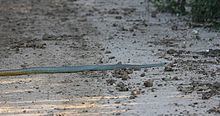Class Reptilia Phylum Chordata Rank Species | Subphylum Vertebrata Suborder Serpentes Order Scaled reptiles | |
 | ||
Similar Chironius, Chironius multiventris, Chironius scurrulus, Brown sipo, Chironius grandisquamis | ||
Chironius laurenti is a species of nonvenomous colubrid snake found in Brazil and Bolivia. The species was named in honor of Raymond Laurent.
Contents
Taxonomy
Chironius laurenti belongs to the genus Chironius (commonly known as sipos or savanes) in the subfamily Colubrinae of the family Colubridae. It was first described in 1993 by the herpetologists James R. Dixon, John A. Wiest, Jr., and José M. Cei. The type specimens were recovered from the Mamoré River of Beni, Bolivia. The species is named after the Belgian herpetologist Raymond Laurent.
Description
The longest male and female found had a total length of 2.15 and 1.78 m (7.1 and 5.8 ft) respectively. The head (top, sides, upper portion of the rostral scales and upper portions of the supralabial scales) of adults is olive, grayish or gray-brown in color. 32 to 36 maxillary teeth are present.
The upper (dorsal) coloration varies between grayish, gray-olive, brown-olive, brown and olive. The anterior end of the dorsum is usually grayish, whereas the posterior two thirds of body and tail are brownish. The subcaudal scales (scales below the tail) are immaculate yellow in color. There are 2 to 10 scale rows in males and 2 to 6 in females, with a maximum of 12 scale rows at midbody. The ventral (belly) scales number from 163 to 181. A longitudinal ridge (keel) is present along the backs of females.
Subadults and some adults have faint whitish crossbands, which are remnants of the juvenile pattern, on the body and the tail.
Distribution
Its known distribution is restricted to Beni, Cochabamba and Santa Cruz in Bolivia and Mato Grosso in Brazil.
